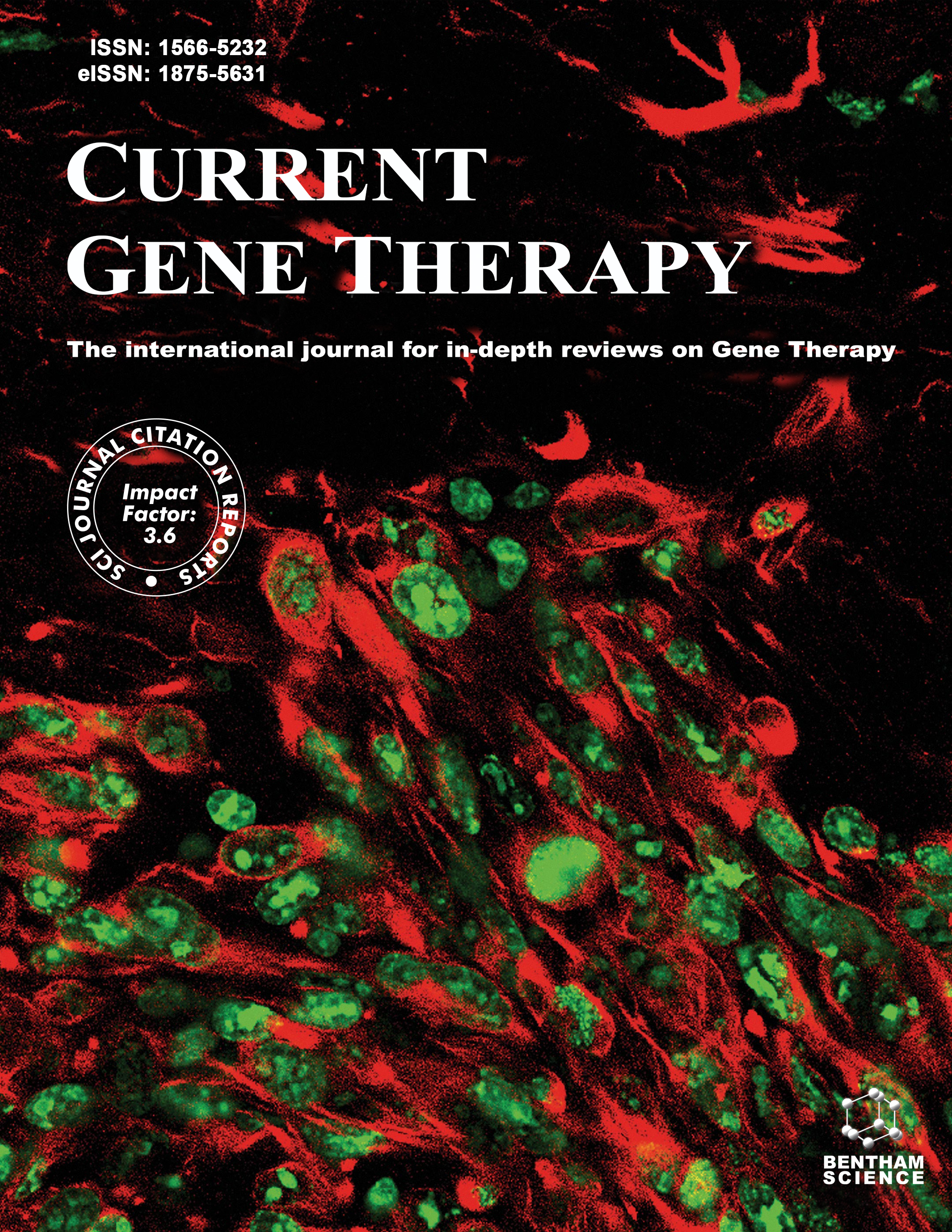- Home
- A-Z Publications
- Current Gene Therapy
- Previous Issues
- Volume 22, Issue 5, 2022
Current Gene Therapy - Volume 22, Issue 5, 2022
Volume 22, Issue 5, 2022
-
-
Cancer Treatment Evolution from Traditional Methods to Stem Cells and Gene Therapy
More LessAuthors: Wenhua He, Qingxuan Li, Yan Lu, Dingyue Ju, Yu Gu, Kai Zhao and Chuanming DongBackground: Cancer, a malignant tumor, is caused by the failure of the mechanism that controls cell growth and proliferation. Late clinical symptoms often manifest as lumps, pain, ulcers, and bleeding. Systemic symptoms include weight loss, fatigue, and loss of appetite. It is a major disease that threatens human life and health. How to treat cancer is a long-standing problem that needs to be overcome in the history o Read More
-
-
-
Perspectives on Genetic Medicine for Cystic Fibrosis
More LessLike any inherited protein deficiency disease, cystic fibrosis (CF) is a good candidate for gene replacement therapy. Despite the tremendous efforts of scientists worldwide invested in developing this approach, it did not lead to the expected results for various reasons discussed in this review. At the same time, the emergence of new methods of genome editing, as well as their latest modifications, makes it possible to bypass som Read More
-
-
-
Poly(rC) Binding Protein 1 Represses the Translation of STAT3 through 5' UTR
More LessAuthors: Ziwei Li, Xiaole Wang and Rong JiaBackground: Signal transducer and activator of transcription 3 (STAT3) is an oncogene and frequently overexpressed in cancers. However, the regulatory mechanisms of STAT3 expression are not fully understood. Poly(rC)-binding protein1 (PCBP1) is an RNA-binding protein that regulates mRNA stability, splicing, and translation. PCBP1 is a tumor suppressor and can inhibit the translation of several oncogenic genes. Objecti Read More
-
-
-
Therapeutic Effects of Mesenchymal Stem Cells Expressing Erythropoietin on Cancer-Related Anemia in Mice Model
More LessBackground: Cancer-related anemia (CRA) negatively influences cancer patients’ survival, disease progression, treatment efficacy, and quality of life (QOL). Current treatments such as iron therapy, red cell transfusion, and erythropoietin-stimulating agents (ESAs) may cause severe adverse effects. Therefore, the development of long-lasting and curative therapies is urgently required. Objective: In this study, a cell and gene t Read More
-
-
-
A Hypoxia-Regulated Retinal Pigment Epithelium-Specific Gene Therapy Vector Reduces Choroidal Neovascularization in a Mouse Model
More LessAuthors: Yun Yuan, Wen Kong, Xiao-Mei Liu and Guo-Hua ShiBackground: Wet age-related macular degeneration (wAMD) is characterized by the presence of choroidal neovascularization (CNV). Although there are some clinical drugs targeting vascular endothelial growth factor (VEGF) and inhibiting CNV, two major side effects limit their application, including the excessive activity of anti-VEGF and frequent intraocular injections. To explore better treatment strategies, researchers dev Read More
-
-
-
Therapeutic Potential of POU3F3, a Novel Long Non-coding RNA, Alleviates the Pathogenesis of Osteoarthritis by Regulating the miR-29a- 3p/FOXO3 Axis
More LessAuthors: Mingmin Shi, Menghao Sun, Cong Wang, Yue Shen, Yangxin Wang and Shigui YanBackground: Osteoarthritis (OA) is the predominant threat to the health of the elderly, and it is crucial to understand the molecular pathogenetic mechanisms involved in it. This study aims to investigate the role of a well-studied cancer-related long non-coding RNA (lncRNA)-POU3F3 in OA and its implicated molecular mechanisms. Methods: The expression of POU3F3 and miR-29a-3p was examined in osteoarthritis patients, as w Read More
-
-
-
Inferring Cell-type-specific Genes of Lung Cancer Based on Deep Learning
More LessAuthors: Nitao Cheng, Chen Chen, Changsheng Li and Jingyu HuangBackground: Lung cancer is cancer with the highest incidence in the world, and there is obvious heterogeneity within its tumor. The emergence of single-cell sequencing technology allows researchers to obtain cell-type-specific expression genes at the single-cell level, thereby obtaining information regarding the cell status and subpopulation distribution, as well as the communication behavior between cells. Many researc Read More
-
-
-
Identification of HnRNP Family as Prognostic Biomarkers in Five Major Types of Gastrointestinal Cancer
More LessAuthors: Xianghan Chen, Ruining Gong, Jia Wang, Boyi Ma, Ke Lei, He Ren, Jigang Wang, Chenyang Zhao, Lili Wang and Qian YuBackground: Heterogeneous nuclear ribonucleoproteins (hnRNPs), a large family of RNAbinding proteins, have been implicated in tumor progression in multiple cancer types. However, the expression pattern and prognostic value of hnRNPs in five gastrointestinal (GI) cancers, including gastric, colorectal, esophageal, liver, and pancreatic cancer, remain to be investigated. Objective: The current research aimed Read More
-
Volumes & issues
-
Volume 25 (2025)
-
Volume 24 (2024)
-
Volume 23 (2023)
-
Volume 22 (2022)
-
Volume 21 (2021)
-
Volume 20 (2020)
-
Volume 19 (2019)
-
Volume 18 (2018)
-
Volume 17 (2017)
-
Volume 16 (2016)
-
Volume 15 (2015)
-
Volume 14 (2014)
-
Volume 13 (2013)
-
Volume 12 (2012)
-
Volume 11 (2011)
-
Volume 10 (2010)
-
Volume 9 (2009)
-
Volume 8 (2008)
-
Volume 7 (2007)
-
Volume 6 (2006)
-
Volume 5 (2005)
-
Volume 4 (2004)
-
Volume 3 (2003)
-
Volume 2 (2002)
-
Volume 1 (2001)
Most Read This Month
Article
content/journals/cgt
Journal
10
5
false
en

Most Cited Most Cited RSS feed
-
-
New Hope for Intervertebral Disc Degeneration: Bone Marrow Mesenchymal Stem Cells and Exosomes Derived from Bone Marrow Mesenchymal Stem Cell Transplantation
Authors: Xiao-bo Zhang, Xiang-yi Chen, Jin Qi, Hai-yu Zhou, Xiao-bing Zhao, Yi-cun Hu, Rui-hao Zhang, De-chen Yu, Xi-dan Gao, Ke-ping Wang and Lin Ma
-
- More Less

